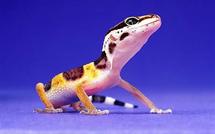
Earlier experiments have shown that "lizard tail autonomy", in the lingo of biologists, provides a visual decoy that entices an attacker to pounce on the tail rather than the gecko.
In addition, traveling light allows the lizard to run even faster, boosting its chances of escape and survival.
On the down side, a tail-less gecko is at a distinct disadvantage when it comes to jumping and climbing. It may also find itself scrambling to find a suitable mate.
Anthony Russell, a professor at the University of Calgary in Canada, and Timothy Higham of Clemson University in South Carolina wanted to take things a step further by analysing exactly how the severed tails move.
Using electromyography (EMG) and high-speed video, they monitored tails from the instant of separation from four specimens of Eublepharis macularius, a.k.a. the leopard gecko.
EMG detects the electric potential generated by muscle cells, both when they are active and at rest, and is frequently used to analyse the biomechanics of movement.
Unlike most animals or animal parts moving without the active control of a brain, the gecko tails didn't simply jerk about in a regular pattern.
"We discovered that the tail has an intricate repertoire of varied and highly complex movements, including acrobatic flips up to three centimetres (1.2 inches) in height," said Russell.
More than a biological curiosity, the new findings could shed light on the functions of the spinal cord and the effects of spinal cord injury, he said.
From an evolutionary vantage point, rhythmic movements interlaced with sudden jumps and flips enhances unpredictability, further distracting the predator, the study conjectured.
Natural selection may also have favoured sustained and complex movement so that the tail can escape too: geckos have been known to return to the scene of their dismemberment to eat their own tail, presumably to compensate for the loss of the precious fats stored there.
More research is needed to understand exactly how a bundle of nerves detached from a brain can perform such complex behaviours, the researchers said.
"The most plausible explanation is that the tail relies on sensory feedback from the environment. Sensors on its surface may tell it to jump, pivot or travel in a certain direction," Russell said in a statement.
While many of the movements seemed to be self-initiated, the tails almost always lunged in a certain way when they touched the edge of the enclosure in which the experiments took place.
The study shows that the signal triggering movement starting at the far tip of the tail, the likely location of a control centre activated only after detachment from the rest of the body -- and the brain -- has occurred.
The study was published in Biology Letters, a journal of The Royal Society, Britain's de facto academy of science.
----------------------------------------------------------------------------------------------------------------------------
In addition, traveling light allows the lizard to run even faster, boosting its chances of escape and survival.
On the down side, a tail-less gecko is at a distinct disadvantage when it comes to jumping and climbing. It may also find itself scrambling to find a suitable mate.
Anthony Russell, a professor at the University of Calgary in Canada, and Timothy Higham of Clemson University in South Carolina wanted to take things a step further by analysing exactly how the severed tails move.
Using electromyography (EMG) and high-speed video, they monitored tails from the instant of separation from four specimens of Eublepharis macularius, a.k.a. the leopard gecko.
EMG detects the electric potential generated by muscle cells, both when they are active and at rest, and is frequently used to analyse the biomechanics of movement.
Unlike most animals or animal parts moving without the active control of a brain, the gecko tails didn't simply jerk about in a regular pattern.
"We discovered that the tail has an intricate repertoire of varied and highly complex movements, including acrobatic flips up to three centimetres (1.2 inches) in height," said Russell.
More than a biological curiosity, the new findings could shed light on the functions of the spinal cord and the effects of spinal cord injury, he said.
From an evolutionary vantage point, rhythmic movements interlaced with sudden jumps and flips enhances unpredictability, further distracting the predator, the study conjectured.
Natural selection may also have favoured sustained and complex movement so that the tail can escape too: geckos have been known to return to the scene of their dismemberment to eat their own tail, presumably to compensate for the loss of the precious fats stored there.
More research is needed to understand exactly how a bundle of nerves detached from a brain can perform such complex behaviours, the researchers said.
"The most plausible explanation is that the tail relies on sensory feedback from the environment. Sensors on its surface may tell it to jump, pivot or travel in a certain direction," Russell said in a statement.
While many of the movements seemed to be self-initiated, the tails almost always lunged in a certain way when they touched the edge of the enclosure in which the experiments took place.
The study shows that the signal triggering movement starting at the far tip of the tail, the likely location of a control centre activated only after detachment from the rest of the body -- and the brain -- has occurred.
The study was published in Biology Letters, a journal of The Royal Society, Britain's de facto academy of science.
----------------------------------------------------------------------------------------------------------------------------









 Home
Home Politics
Politics









